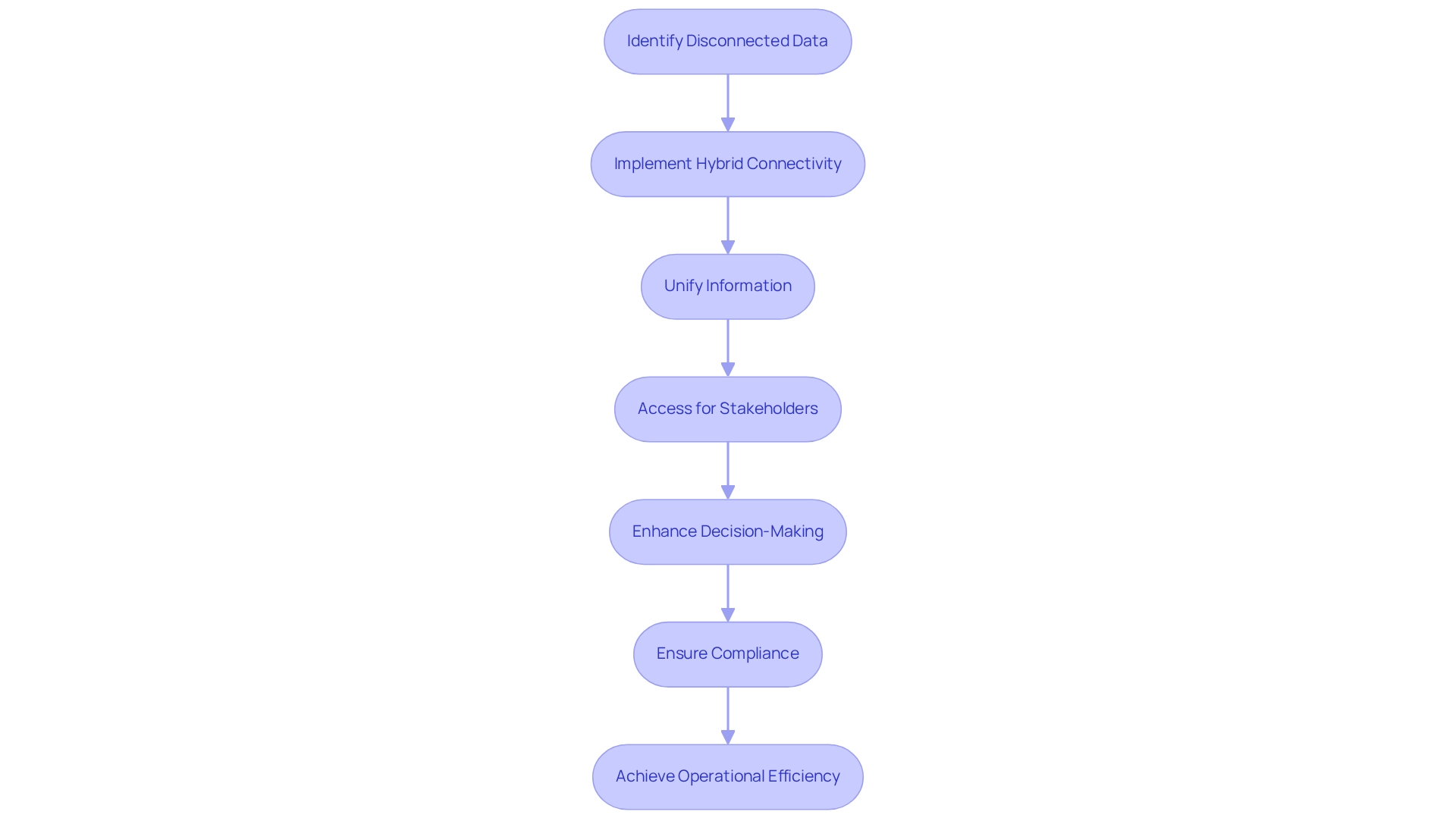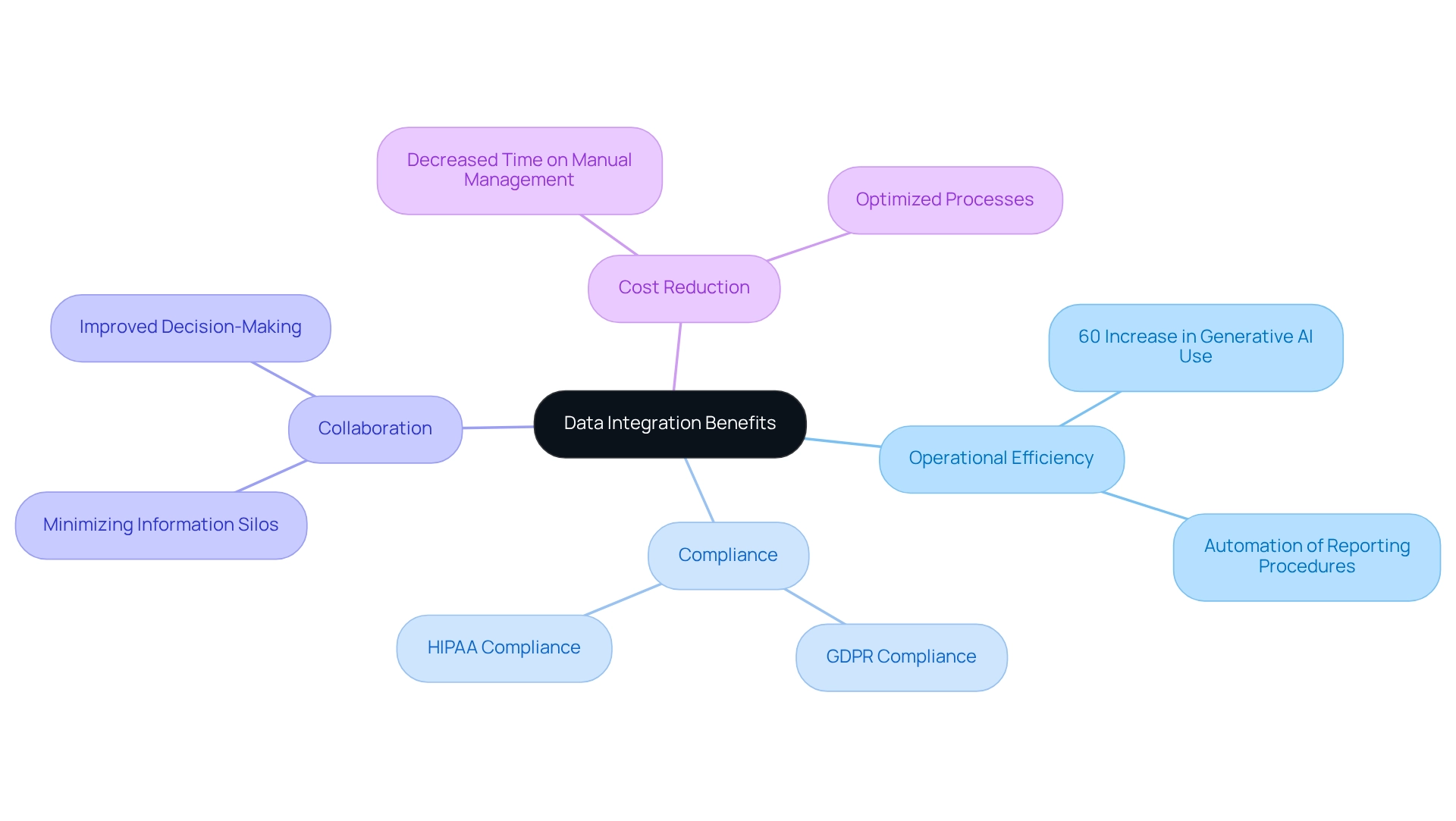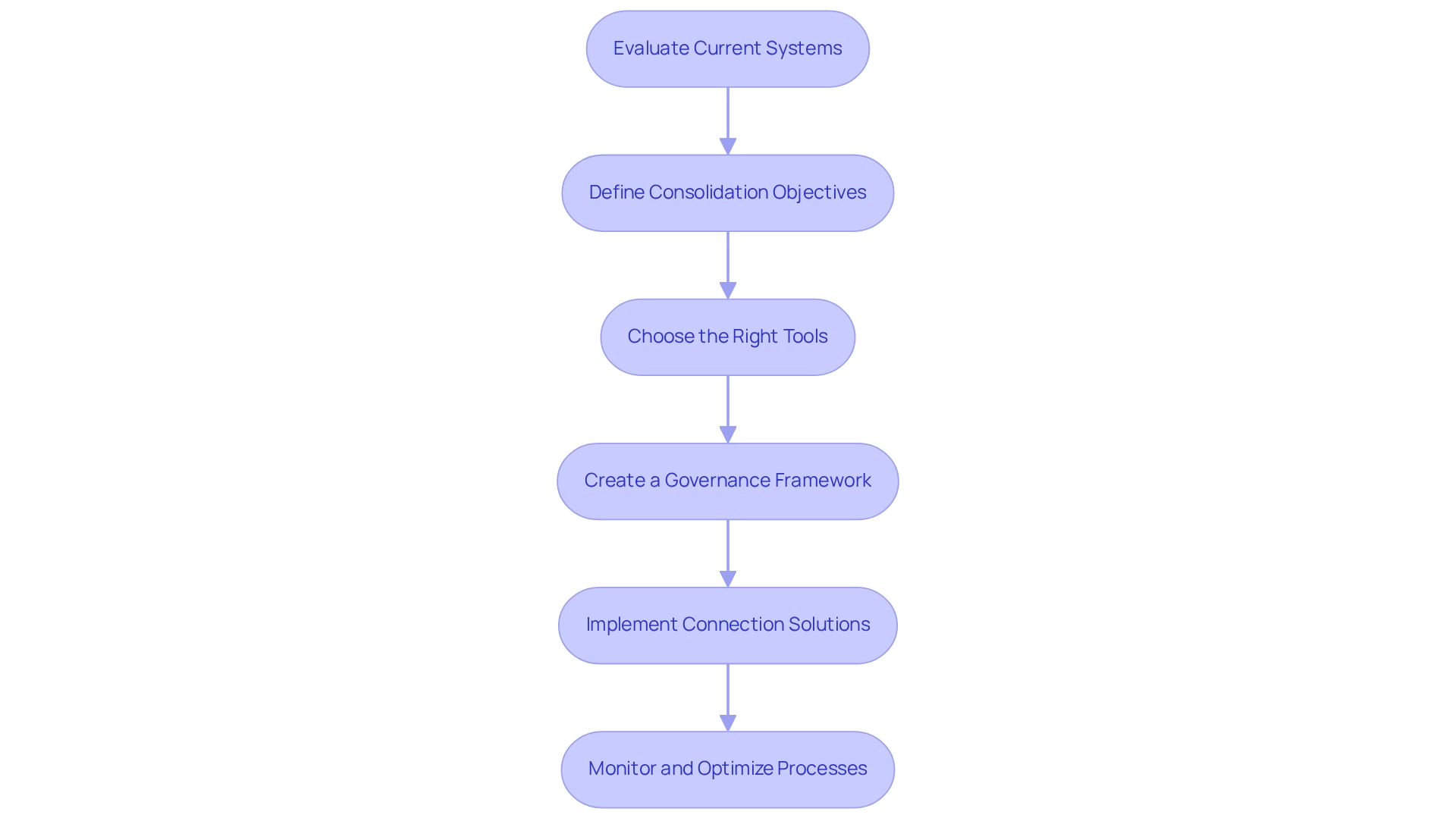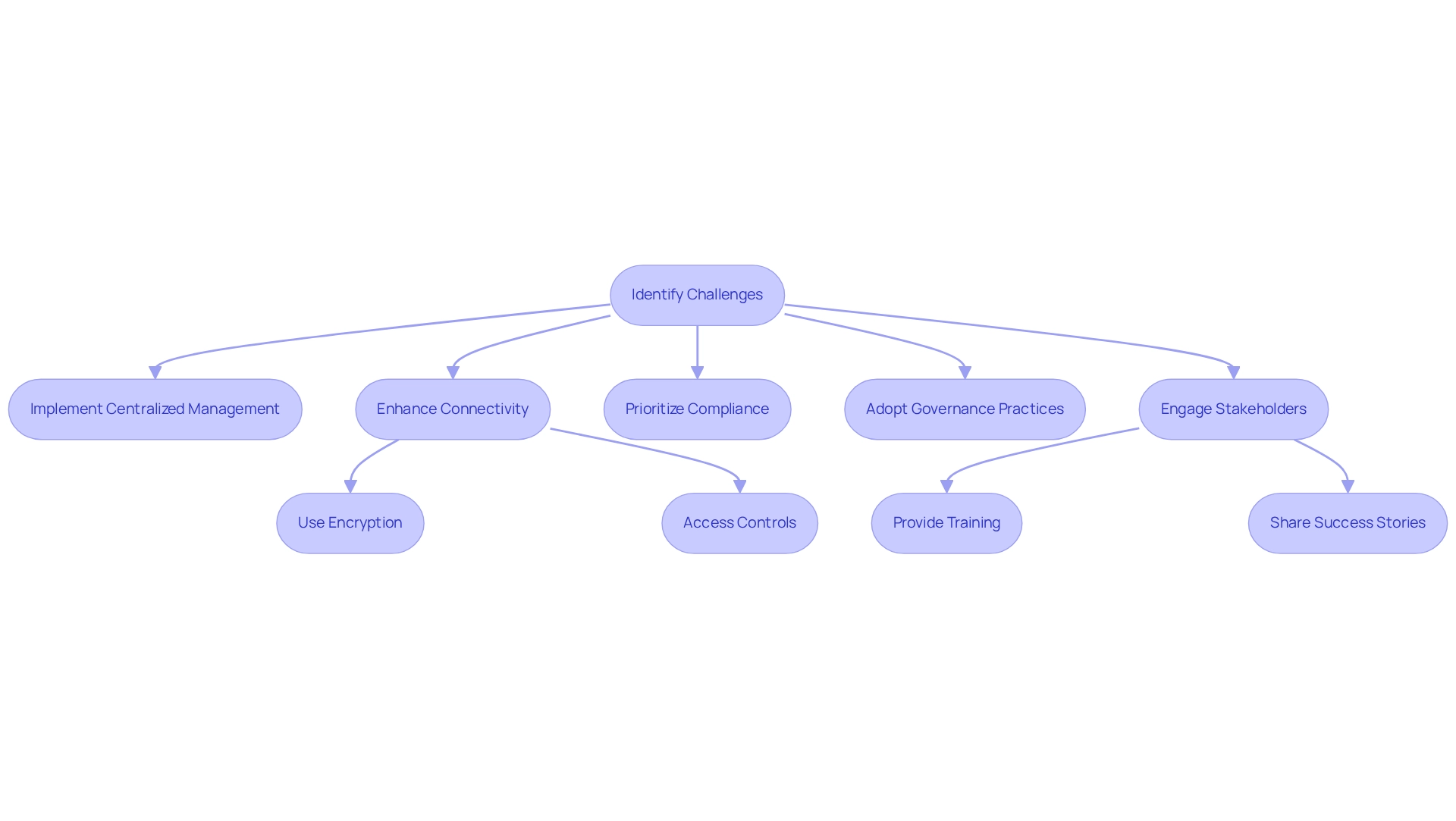Overview
We recognize the critical importance of data integration for IT managers, especially in enhancing operational efficiency and ensuring compliance within sectors such as banking and healthcare. Effective data integration unifies isolated information systems, improves decision-making, and streamlines processes. This ultimately fosters innovation and reduces costs.
What challenges are you facing in achieving seamless data integration? By addressing these issues, we can empower your organization to harness the full potential of its data, driving better outcomes and strategic advantages.
Let us partner with you to transform your data landscape into a cohesive, efficient system that supports your goals.
Introduction
In today’s technology-driven world, data integration is not just an option; it is a critical pillar for organizations aiming to enhance operational efficiency and compliance, especially in sectors like banking and healthcare.
As we navigate the complexities of disparate data systems, the ability to unify data from multiple sources becomes paramount. Effective data integration streamlines decision-making and ensures stakeholders have access to accurate information—a necessity for meeting regulatory standards.
With innovative solutions like our hybrid integration platform, we can unlock the potential of legacy systems, paving the way for improved collaboration and agility.
This article explores the multifaceted benefits of data integration, providing a comprehensive guide for IT managers to navigate challenges and implement effective strategies that drive digital transformation.
Define Data Integration and Its Relevance to IT Management
The importance of data integration is crucial for IT managers who oversee complex networks that often operate in isolation. We understand that in sectors like banking and healthcare, where the importance of data integration is paramount for ensuring information accuracy and accessibility, effective unification ensures all stakeholders have access to the same details. This not only facilitates improved decision-making but also ensures compliance with regulatory standards.
Our dedicated hybrid connectivity platform empowers IT managers to maximize the value of legacy technologies while simplifying intricate connections and significantly reducing costs. By unlocking disconnected information and infrastructures in weeks, not months, we enable organizations to align their technology strategies with their objectives, ultimately fostering innovation and efficiency.
Our platform supports 12 stages of interface maturity, striking a balance between speed and sophistication in integration. Understanding the importance of data integration through our solutions provides IT managers with the essential tools for effective digital transformation and seamless system integration.
As Gustavo Estrada, Acting Provincial Director at BC Provincial Health Services Authority, notes, our approach significantly enhances operational efficiency. What’s holding your team back from achieving similar results?

Explore the Benefits of Data Integration for Operational Efficiency and Compliance
The importance of data integration is not just an option; it is a necessity that significantly enhances operational efficiency and compliance, particularly in the financial services sector. By harnessing generative AI, we minimize information silos, enabling a seamless flow of information across our departments. This transformation leads to improved collaboration and faster decision-making, especially when we utilize advanced technologies like sophisticated chatbots and virtual assistants for customer engagement.
Have you noticed the 60% increase in the use of generative AI for enhancing customer experience? This statistic underscores its transformative impact. Furthermore, the importance of data integration in integrated data networks enhances data precision, which is essential for compliance with regulations like GDPR in banking and HIPAA in healthcare.
Our hybrid connectivity platform accelerates secure system unification, allowing us to optimize processes and improve efficiency across multiple departments. As Tony LeBlanc from the Provincial Health Services Authority noted, our team is extremely professional and knowledgeable, which reflects in our ability to deliver results.
Moreover, by combining information, we can automate reporting procedures, significantly decreasing the time and resources spent on manual information management. Ultimately, understanding the importance of data integration leads to cost reductions and a more robust competitive stance in the market, enabling us to safeguard our operations through seamless information and network unification.
Let us partner together to unlock these benefits for your organization.

Implement Data Integration: A Step-by-Step Guide for IT Managers
We begin by evaluating our current systems. It’s essential to examine existing information sources and systems to understand the importance of data integration in pinpointing connection points. By comprehending the information formats, storage locations, and access protocols, we can recognize the importance of data integration to streamline our approach. Utilizing XSLT, with its declarative characteristics and seamless integration with XPath, simplifies this process significantly, enabling effective querying and transformation of XML structures.
Next, we define our consolidation objectives. What do we aim to achieve through information amalgamation? This could include improving data accuracy, enhancing reporting capabilities, or ensuring compliance with regulations, which underscores the importance of data integration. By employing schemas alongside XSLT, we can eliminate entire categories of programming mistakes, ensuring that our unification objectives are met with precision.
Choosing the right tools is crucial. We select connection tools that align with our organization’s needs, considering factors such as scalability, security, and ease of use. Tools like Avato streamline this process, offering robust integration capabilities, especially when paired with XSLT for XML transformation.
Furthermore, we create a governance framework. Establishing policies for information quality, security, and compliance underscores the importance of data integration. This framework will guide how we handle and integrate information across the organization, emphasizing the importance of data integration to ensure that all transformations adhere to regulatory standards and security audits.
As we implement connection solutions, we initiate the unification process by linking information sources using our selected tools. It’s imperative to understand the importance of data integration, ensuring that information flows seamlessly between systems and that necessary transformations are applied. XSLT’s declarative nature facilitates simple implementation, reducing the complexity often associated with data merging tasks.
Finally, we monitor and optimize our processes. After implementation, we continuously observe performance and accuracy. Utilizing real-time analytics allows us to identify areas for enhancement, ensuring we streamline the combination as needed. The cost-saving benefits of using schemas in conjunction with XSLT can lead to significant reductions in development costs due to fewer defects and enhanced maintainability.

Identify and Overcome Challenges in Data Integration for Banking and Healthcare
As IT managers, we must navigate the unique challenges presented by the importance of data integration in banking and healthcare. The importance of data integration is evident as many organizations operate with separate information repositories, making it difficult to achieve a cohesive perspective. To overcome this, we recommend implementing a centralized information management strategy that emphasizes the importance of data integration and fosters sharing across departments.
Our hybrid connectivity platform excels in unlocking isolated assets and facilitating seamless connections, emphasizing the importance of data integration by providing a comprehensive overview of information across systems. We are committed to addressing intricate challenges, ensuring that our clients can efficiently handle their information management requirements while recognizing the importance of data integration to overcome compliance issues that regulatory requirements can complicate.
We must remain aware of the importance of data integration and ensure that our unification procedures adhere to pertinent regulations. Our solutions are crafted with compliance as a priority, highlighting the importance of data integration to assist organizations in successfully navigating complex regulatory environments. For instance, we have effectively supported clients in the healthcare industry to meet strict compliance demands through customized coordination strategies, demonstrating the importance of data integration, as subpar information quality can lead to flawed insights.
We advocate for implementing governance practices that underscore the importance of data integration, emphasizing accuracy and integrity throughout the merging process. Our specialized unification services demonstrate the importance of data integration by helping enterprises uphold high information quality standards, ensuring that combined information is both reliable and usable.
By leveraging our global network of collaboration partners, organizations can access the expertise required to enhance information quality, which underscores the importance of data integration while addressing security concerns, as protecting sensitive information is paramount, especially in healthcare. We advise employing encryption and access controls to secure information, reflecting the importance of data integration during merging. Regular security audits can help identify vulnerabilities.
Our emphasis on the importance of data integration in unification processes includes robust measures to safeguard sensitive information throughout its lifecycle. Clients have reported increased confidence in their data security following integration with our solutions, which underscores the importance of data integration in overcoming resistance to change that can obstruct unification efforts.
We encourage engaging stakeholders early in the process and providing training to highlight the importance of data integration for ensuring a smooth transition to integrated systems. Our team of proficient collaboration partners recognizes the importance of data integration by delivering client-focused solutions and support, enabling effective change management and ensuring a successful unification journey. By sharing success stories from previous clients, we demonstrate our commitment to guiding organizations through the integration process.

Conclusion
Data integration is not just beneficial; it is essential for organizations striving to enhance operational efficiency and ensure compliance, especially in sectors like banking and healthcare. By unifying disparate data sources, we empower IT managers to deliver accurate information to stakeholders, thereby improving decision-making and meeting regulatory standards. Our solutions, such as Avato’s hybrid integration platform, simplify the integration of legacy systems, reduce costs, and foster collaboration across departments.
The advantages of data integration extend beyond mere operational improvements. With the advent of generative AI, we can dismantle data silos, automate reporting, and elevate customer engagement—all while upholding data accuracy to comply with regulations such as GDPR and HIPAA. This capability not only fortifies our competitive positioning but also equips businesses to navigate future challenges effectively.
To realize effective data integration, we recommend that IT managers:
- Assess current systems
- Establish clear objectives
- Select appropriate tools
Implementing a robust data governance framework is crucial for addressing challenges like data silos, compliance issues, and security concerns. Our expertise at Avato in guiding organizations through this intricate process underscores the vital role of professional support in achieving successful integration outcomes.
In conclusion, prioritizing data integration is imperative for organizations aiming to thrive in a technology-driven landscape. By leveraging integrated systems, we can enhance operational efficiency, ensure compliance, and drive digital transformation, ultimately setting the foundation for long-term success.

